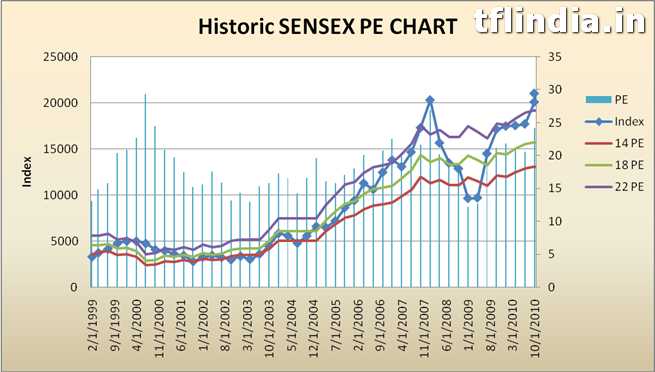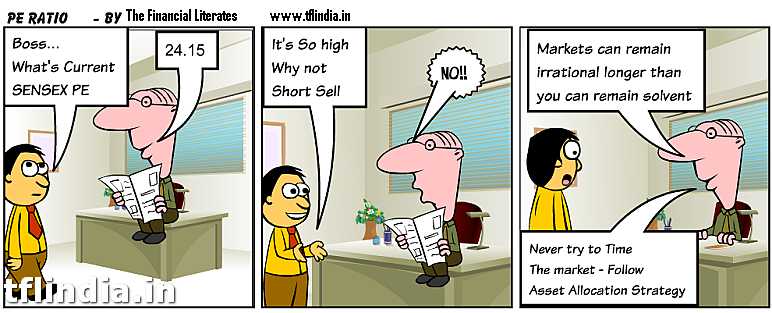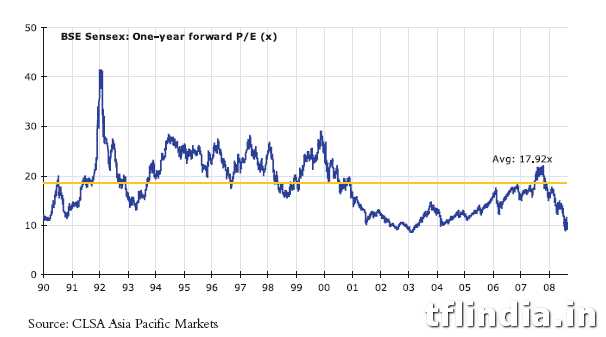Understanding Value of Equity Markets
One of the greatest Investor Warren Buffet says “The stock market is filled with people who know the price of everything but the value of nothing” What does he wants to convey when he says PRICE and VALUE and is there any difference between these two.
Let me give you an example to explain this: would you buy a simple new pen of REYNOLDS for Rs. 1000. I am sure you would not. But if I ask you to buy the same for Rs. 1, would you be interested in it. Probably YES. Now here is the difference between PRICE and VALUE. Both Rs.1000 and Re. 1 are price of that pen quoted by the seller but your decision to buy that pen or not to buy the pen is not based on the price but what VALUE you derive from that. At 1000, the pen looks costly but at Re. 1 it looks cheap. Value is the utility that you derive by paying a price to a particular thing. This is why we say at times, Ye CHEEZ AAP MEHENGI LE AAYE ya fir YE CHEEZ AAP SASTI LE AAYE. But in the case of investments, how do you ascertain its VALUE.
Read – Types of Indian Investor
Value of Investment
Utility in investment is calculated by the return it would generate in one year’s time and this is known as PE or Price to Earnings. PE is nothing but the price that an investor is ready to pay to earn Re.1 every year. To make it simple, if you have invested Rs. 100 in a FD which is giving you an interest of 8%, at the end of the year you would get Rs. 8. In other words, to earn Rs. 8, you need to invest Rs. 100 or to earn Re. 1, you need to invest Rs. 12.5 (100/8). And hence the PE of bank FD is 12.5. Now if the interest rate had been 12%, the PE would have been 8.33. Now if PE is low, you expect higher return and if PE is high, you expect lower return.
Is the stock market something different? It is a place where shares are bought and sold. The seller demands a price that is quoted on Screen but do you know the VALUE. For example, let say Reliance is quoted at Rs. 1000 per share. Now, this is the price but what is the VALUE. Not many would have the answer. So we all understand the price in the stock market as it is quoted before us, but we seldom understand its VALUE.
Must Read- What is Sensex and Nifty
Calculated PE of any stock
To understand the value of the share market, we need to understand the PE of SENSEX. But let’s first try to understand how P/E is calculated for a single stock.
PE=Price (MPS-Market Price Per Share )/Earning (EPS-Earning Per Share)
To understand PE, we need to first understand the Price and the earning per share (EPS) of stock for this we take the example of Infosys. The current Market Price of Infosys is Rs. 3000. Now, what about earning per share? If we divide the Total Net profit (past 12 months) of Infosys by the number of shares it has, we will get what is known as Earning per share so the EPS of Infosys comes out to be 111. Now we can divide Price by EPS, we will get Infosys current PE that is 27(3000/111). In simple words, PE is nothing but the price that investors are ready to pay to earn Re. 1 every year. So in the case of Infosys people are ready to pay Rs27 to earn Rs. 1 every year.
Must-Read- Health insurance for diabetics
BSE SENSEX PE Ratio equity
To understand Sensex PE Ratio, we need the price and the earnings of Sensex. Sensex is nothing but price movement of 30 big companies in India like RIL, Infosys, TCS, Maruti etc. Price of Sensex is nothing but what is quoted before us – Sensex at 20000 or Sensex at 21000. Now, what about earnings? Now, these companies are working for profits which are meant for owners of the company. In the case of companies, owners are shareholders. Now if we divide the Total Net profit of the company by the number of shares it has, we will get is known as Earning Per Share (EPS). Now if we add the EPS (according to weightage – for eg. weightage of reliance in Sensex is 11% its current EPS is 53 so 5.83 will be used similarly for other companies) of all 30 companies, we get the EPS of Sensex. The combined EPS of Sensex is the earning which we were looking at. Now PE of Sensex is nothing but Level of Sensex/EPS.
Must Read – Learn about Financial Goals
SENSEX PE Chart
In the above chart Blue Bars are showing Sensex PE (right-hand axis) from 1999 till date – March 2000 it reached to 30 & then came back to 13 in Jan 2002. In 2007 it was again closed to 29 & in starting of 2009 it went close to 10 (a time that was missed by maximum investors & even so-called experts). Average Sensex PE from 1990 to 2010 remained close to 18. Current Sensex PE is close to 24.15(when the market touched 21000). Blue Dotted Line shows the real movement on Sensex (left-hand axis). As we have seen that average PE in India was close to 18 so the green ribbon(line) shows if the market would have remained close to that PE. Red ribbon shows undervaluation (14 PE) & Purple ribbon overvaluation or stretched valuation. Currently, it’s above purple ribbon (stretched valuation) but that doesn’t mean it should have to fall now – we have already seen that in 2000 & 2007 it was close to 30 & in 1994 it even touched 50 before it came down. Nobody can time market this article is there is to share the concept.
Don’t do this mistake (Click on the Cartoon to enlarge)
Earnings (EPS) of Sensex
You shall be surprised to know that the combined earnings of Sensex companies in 1992 was 80, in 2000 was 240 & now 860. This EPS growth directly convert into growth of Sensex from 1992 (Sensex was close to 2000) till today EPS has grown 10 times & our Sensex has grown same 10 times. Now Indian businesses are growing and so as the profitability of the companies. In this case, EPS is bound to go up and so as Sensex. I don’t want to comment on where sensex could be in next 1 month of 6 months as in short term anything could happen but with reasonable confidence, I can surely say that in 5 years down the line, Sensex will be much higher than where we are today. Don’t listen to analysts just follow basic rule of earning growth.
You can check the latest Current Sensex PE Ratio here.Few more PE Concepts
The concept we have read above in technical language is called trailing (past) PE. There are a few other types of PEs- Forward PE, Rolling PE & Diluted PE. Other than trailing PE (normal PE) only Forward PE is heard by you on daily basis (Thanks to our so-called analysts & investment gurus –
Read Stop Fooling Investor.
Forward Sensex PE
There is not a major difference in the method of calculation – in normal PE past 12 months EPS is taken & in Forward, PE future expected PE will be taken. For example, if current PE is 23 & some analyst believes that EPS of Sensex companies should increase by 20% – he will say next year EPS (current EPS 862) will be 1035 so 1 year forward PE is 19.6. There is nothing wrong in doing it but in a bull market when the expectation of growth is very high this can give some deceiving figures. Even analyst Some time quotes 2 years forward PE.
Historic 1 year Forward PE Chart ( from 1990)
PE is a very relative term it will be different for different markets, sectors, stocks – it actually shows investor expectations. PE also reflects the strength & future prospectus of the company. It should definitely be considered before making a lumpsum equity investment but it should not be the only criteria. We request all readers to participate in equities through the Mutual Fund route rather than going directly.
Please let me know do you liked this article & would you like to learn some more basic & important concepts like the Sensex PE ratio. Feel free to ask any question other than which stock should you invest in.






One of the most important information oriented article.
Hats of to you for sharing such a nice article.
krishna
Thanks Krishna
If you like our articles please share it with your friends. Gyan batne se badhta hai
Sure….
its my pleasure….
krishna
I Want To Know whats the EPS of BSE in 1994..??
What is bse sensex current forward p/e ?
Hi Pramod,
Current forward PE will depend on what kind of expectation you have from earnings(EPS). If one thinks EPS should grow more PE will be low – if someone thinks EPS will grow slightly PE will be high.
Read this
For example if current PE is 23 & some analyst believes that EPS of Sensex companies should increase by 20% – he will say next year EPS (current EPS 862) will be 1035 so 1 year forward PE is 19.6.
Is the indian sensex overvalued ?
Hi Manish
If we see history – answer is Yes.
But if we expect that Indian corporates can grow by say 20-22% in next 10 years then it is not.
PE is very relative term – should not be used in isolation
@HM
REALLY DO YOU EXPECT THAT INDIAN CORPORATES COULD GROW 20-22%, OR AT LEAST 15% P.A. IN NEXT 10 YEARS?
Hi Bharat,
Definitely not 20-22% that was just to explain – but not less than 15% in next 10 years.
But the important thing if we are in 30s – game is not of 10 years but 40 or 50 years.
What is Price to earnings ratio?
Jitesh
Price earning ratio & PE Ratio is one & same thing
Please tell current pe of all sensex companies ?
Hi Vishnu
we don’t track that but you can get it everyday in economic times.
Dear Hemant,
Thanks for your valuable insights. I have been following your website regularly. I have a query regarding current market PE.
The present Sexsex PE is around 20. I see people still buying in bluchips. What is the logic of a retail investor of buying at such high PE for long term when the current FD PE is 12.5.
Looking forward to hear your valuable insights on the same.
Hi
If you have read above article – PE is very relative term it will be different for different markets, sectors, stocks – it actually shows investor expectations. PE also reflects strength & future prospectus of the company. It should definitely be considered before making lumpsum equity investment but it should not be the only criteria. I am not saying that we should invest or not invest at these levels – because we can’t time the markets.
Actually current PE is 23 & not 20. If we see past data – If someone would have invested at such levels of PE(24), average returns were negative even if someone hold investment for 2 years. (probability of getting positive return is 0%) Best way to avoid/ignore greed & fear cycle is asset allocation. We will soon write an article on asset allocation.
Insightful article on investments. Keep it up.
Markets tend to work in the future , so one has to factor the future and not work in the past earnings. There fore I feel that we must be able to factor forward PE ratio(future tense) more than trailing PE(Past Tense). What get me tensed is with foward earnings is that it is based on certain assumption and is estimated by analysists who can be bought.
Is there any credible and unbiased website that publishes the forward PE ratios,
just like the BSE does for trailing PE. Do let me know.
Thanks
Prakash Mahtani
Thanks Prakash.
You are right but legends like Buffett or Bejamin Graham promoted past consistency rather than future forecasting.
It’s really difficult to forecast future – I still remember in 2007 top analyst & FIIs were forecasting Sensex 1000 EPS in 2008-2009 but still we are at 860.
Forward PE creates illusion bcoz we are considering profits that have not been pocketed.
nice article … other than ET is there any source where i can get authentic info about pe??
how about nse, bse?
i am fresher to equities…have just spent few weeks studying equities…
thanks a lot..
Hi Chetan,
Every business paper publishes PE on regular basis. But my suggestion is not to get involved in direct equities.
Hi Hemant,
Can anytime forward PE can be higher than trailing PE.
Hi Vikas,
Yes it is possible if their is an expectation that earnings of company will reduce.
It’s a very good artical.
I shell like to ask one thing releated to PE ratio.
Sensex PE band is 10 to 25.Present PE is around 20.Now the question is shell I wait to invest lumsum in equity mutual fund untail PE ratio comes down below 15.
Please advaise.
Hi Mandar,
Partial amount you can invest now – rest you can invest through 3-6 months STP.
Hi Hemant
I know about STP & SIP,I want to know proper time releated to PE to enter in equity.
Hi Mandar,
I don’t know the answer or other way round I think no one can answer this question.
You should follow asset allocation strategy – rather than predicting markets. More wealth is lost in waiting for correction than in correction itself. So see the bigger picture – if you feel equity is going to deliver better returns in next 5-10-15 years; go & invest in mutual funds.
Dear Hemant,,
your write ups are really worth reading… i invest in only small enterprise… occasionally in Mid-Caps… Today the pe ratio of sensex is 21.35 and nifty 22.43.
( Again in danger zone.. Hope with good q4 Nos. it would come down) Whereas the PE Ratio of BSESMLCAP is 14.54.. Am I to understand that small cap stocks are still undervalued. Want your opinion on this.
2ndly it is about Textile industry. I have been doing study on textile sector for quite some time. I have observed that since 2006 till 2009 most of the textile companies earnings were down ( stock price followed.. quite natural ) but for last 4-5 qtrs. there has been remarkable turnaround.. both in topline and bottomline… but the stock prices has not picked up. E.g Sel Manufacturing’s last 4 qtrs. PAT is 78.77 Crores whereas Mcap is just 206 cr. same is the case with shri lakshmi cotsyn 92.67 and mcap is just 206 cr… these are extreme cases but the story is same for most of the textile companies.. what is you opinion on this
Thanks Gopal but I don’t track stocks or sectors.
Only 1 thing normally PE of small caps stays a shade lower than large caps.
hi, your expected come true.. mkt corrected. now preparing cash for value buying.
Hi Rk,
That’s true that market nosedived from the time we wrote this article but be very frank that we never predicted it. I think its a waste of time to timing market. Retail investors should stick to there basics investing principles.
based PE how to select the stocks, low PE stocks or high PE stocks
for exp. dabur india quoted @40.17 PE & SBI @17.7
Hi Narsimha,
They are from different sectors so PE won’t make much sense.
very good artical in simpel language.Always explane by giving calculations in datails.
I shell like to know more about company debt.
Thanks Mandar.
i thanks to you
Thanks Rahul
i want to know where can i monitor sensex p/e historical chart regularly
Hi Veeraj,
I am not sure but you can try yahoo finance.
dear hemant
you ar doing the great job by publishing valuable article to the new budding investors.
thanks and warm regards
Thanks Yash.
Hi Hemant,
Can you send me link for for pre-1999 BSE PE history? Is there some historical data for series of interest rates vs prevailing PE’s.
thanks,
ramesh
Hi Ramesh,
I am not having that data – else I would have used that in the post
very interesting,simple words simple calculation.. thanx hemant
Thanks Danes.
Thanks for this brilliant article.
Want to know how the Current Market Price of a Company is decided & who decides it.. And how & who provides weightage to the Top 30 companies for calculation of EPS in sensex?
Thank you, sir! This is one of the best and short article on market. Very valuable.
Though I am a small baby of 3 years old in stock market world, just been baptised in the nitty-gritty world of equities yet I found your article on P/E, quite informative, educative, enthralling and stimulative. Amongst the plethora of also-ran authors on the subject often frightening with mumbo-jumbo terminologies you stand apart by clear and lucid explanations.
Please accept my sincere pats, hats-offs, encomiums and adulations !!!
R.Kesavan.
Thanks Kesavan
Hi
Is there any credible and unbiased website that publishes the forward PE ratios,
Do let me know a reliable source for forward pe data.
Thanks
Prakash Mahtani
Hi Prakash,
Forward PE is based on guessing the earning numbers for next year – no one can hit bulls eye regularly.
Do let me know a reliable source for forward pe data.
Thanks
Hemanth,
Before investing any fund do we really need to consider PE of that fund? I have from the above article that its a very relative term. But still I want to clear the doubt with you.
Nice article
what is the average pe ratio of BSE?
how about investing in tata equity pe fund ???
Thanks for such a nice description of P/E ratio. Even a new person like me can understand what this ratio means. I have a query. Today is 4th December 2014. If I want to know what is the value of One year forward P/E currently where can I find this?
Hello,
The forward p/e will depend on the forward eps that different agencies project basis their own in-house analyses of the stocks under study. Hence there is no “single” forward p/e. You will have to surf the net extensively and get an idea of what are the different pe’s being projected. Hope this makes sense!
Hi Hemant,
I came to know that there is consolidated PE ratio also of sensex which is likely to be lower than standalone PE ratio.can you please provide what is the consolidated PE of the sensex?
Hello
great article. I am trying to find the EPS of the index for my research. can you hep me with that?
Hi Anish,
Check NSE bse sites
Hi Sir,
I am Ajay my earning is a small but I want to some money from share market so which type of share purchase to earn money low risk please suggest me
Hi Hemant,
Truly a well thought article written with alacrity. Can u help in getting Historical P/E data, dividend yield of Sensex for the period 1979-1997?
Lke it.
A very informative article in simple words without any technical jargon
Super Article, concepts really explained very well, very nice.
Regards
Sarang
Thanks Sarang
hi Hemant,
can we calculate PE ratio of Mutual funds?
Yes
Comments are closed.